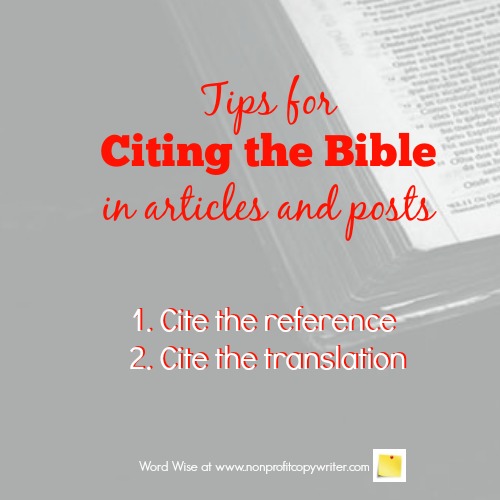Save Time: Get 5 Simple Writing Tips
you can put to use in 10 minutes
Tips for Citing the Bible in Devotionals, Blogs, Articles
Award-winning writer Kathy Widenhouse has helped hundreds of nonprofits and writers produce successful content , with 750K+ views for her writing tutorials. She is the author of 9 books. See more of Kathy’s content here.
Citing the Bible is an essential skill for writers because The Holy Bible is ubiquitous. The best-selling work of all time is quoted often.
You will follow a unique game plan when you cite the Bible in books.
But when it comes to quoting scripture in articles, posts, and devotionals – any shorter piece, even if it does not target a Christian market – you want to make sure you’re following best practices for citation.
Be Legal When Citing the Bible
There are a couple of reasons it’s important to cite the Bible accurately.
The most practical is a legal one. While classical religious texts do not require a formal citation in a footnote or an APA-style reference listing in an article or short post, nevertheless you must include an in-text citation in order to comply with copyright law. The Bible is a published work. Good writers cite those they quote.
Be Clear When Citing the Bible
Legalities aside, proper citation of scripture gives clarity for your reader. When you’re accurate, she will be able to use your citations to read more.
There are two elements to consider when you create your citation: the reference to the passage and the translated version of the Bible.
1. Tips to Help You Cite the Reference Clearly
The reference is the location where the reader can find the passage if he looks in the Bible. It includes the name of the book, the chapter in that book, and the specific verse or verses you quote. List them like this: John 3:16 or John 3:16-17.
- When you cite the reference after the quote, place it in parenthesis: “For God so loved the world that he gave his only Son, that whoever believes in him should not perish but have eternal life” (John 3:16, ESV).
- When you cite the reference before the quote, you needn’t place it parenthesis, but be sure to cite the version in parenthesis: One of the most beloved scripture passages comes from John 3:16: “For God so loved the world that he gave his only Son, that whoever believes in him should not perish but have eternal life” (ESV).
- Cite the reference even if you paraphrase the passage: God loves us so much that he sent us a savior so we can be with him forever (John 3:16).
2. Tips to Help You Cite the Specific Translation Clearly
Use a comma after the reference, followed by the version abbreviation in capitals, to indicate the specific version you quote: John 3:16, KJV. (For a list of Bible versions and appropriate abbreviations, see Bible Gateway.) If you quote the Bible later in your piece but use the same translation as you did in the first citation, you needn’t reference the version again. Different version later in the piece? Cite it.
“Do I really need to cite the translation?”
More than 900 versions in the English language alone can create confusion. A reader who regularly uses the New International Version (NIV) may see your piece based on a scripture used from the New Living Translation (NLT). The wording is different from the reader’s usual reading but it speaks to her in a new or different way. She may want to read the context or even the entire chapter. Yet without the reference to the NLT, she will head over to her trusty NIV. She won’t see the same terms and will get confused.
As a writer who wants to give her clarity in a noisy, jumbled marketplace, you want to avoid this stumbling block. By referencing the translation, you clear up her confusion. You lead the reader to a new insight and to a deeper study of scripture.
Which is a great reason enough to slap that reference in there.
More Tips for Christian Writing
Christian Writing Resources for content creators, freelancers, bloggers ...
Understanding Bible translations: an overview for writers ...
Just Take A Step: a Devotional Bible study for the busy and overwhelmed ...
What makes for good Christian writing?
How to find Christian freelance writing jobs ...
How to choose a scripture for your devotional ...
What Can a Sci-Fi Writer Teach Me about the Christian Market?
Christian Writers Market Guide: do you need it?
Writing Devotionals That Stick: a step-by-step guide ...
Return from Tips for Citing the Bible to Nonprofit Copywriter home
As an Amazon Associate I earn from qualifying purchases.
Share This Page

Named to 2022 Writer's Digest list
BEST GENRE/NICHE WRITING WEBSITE


Stop Wasting Time!
Grab your exclusive FREE guide, "5 Simple Writing Tips You Can Put to Use in 10 Minutes or Less"












